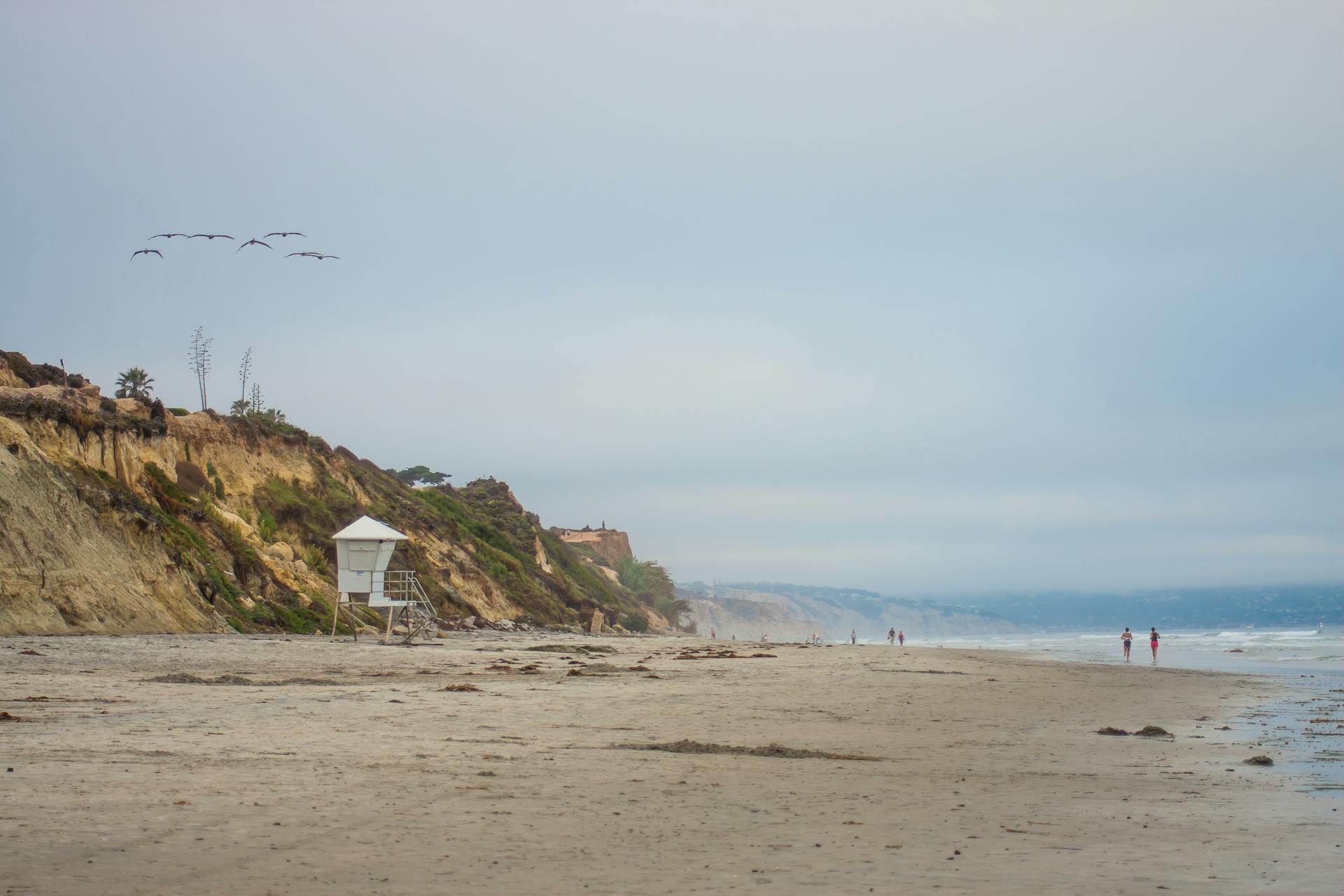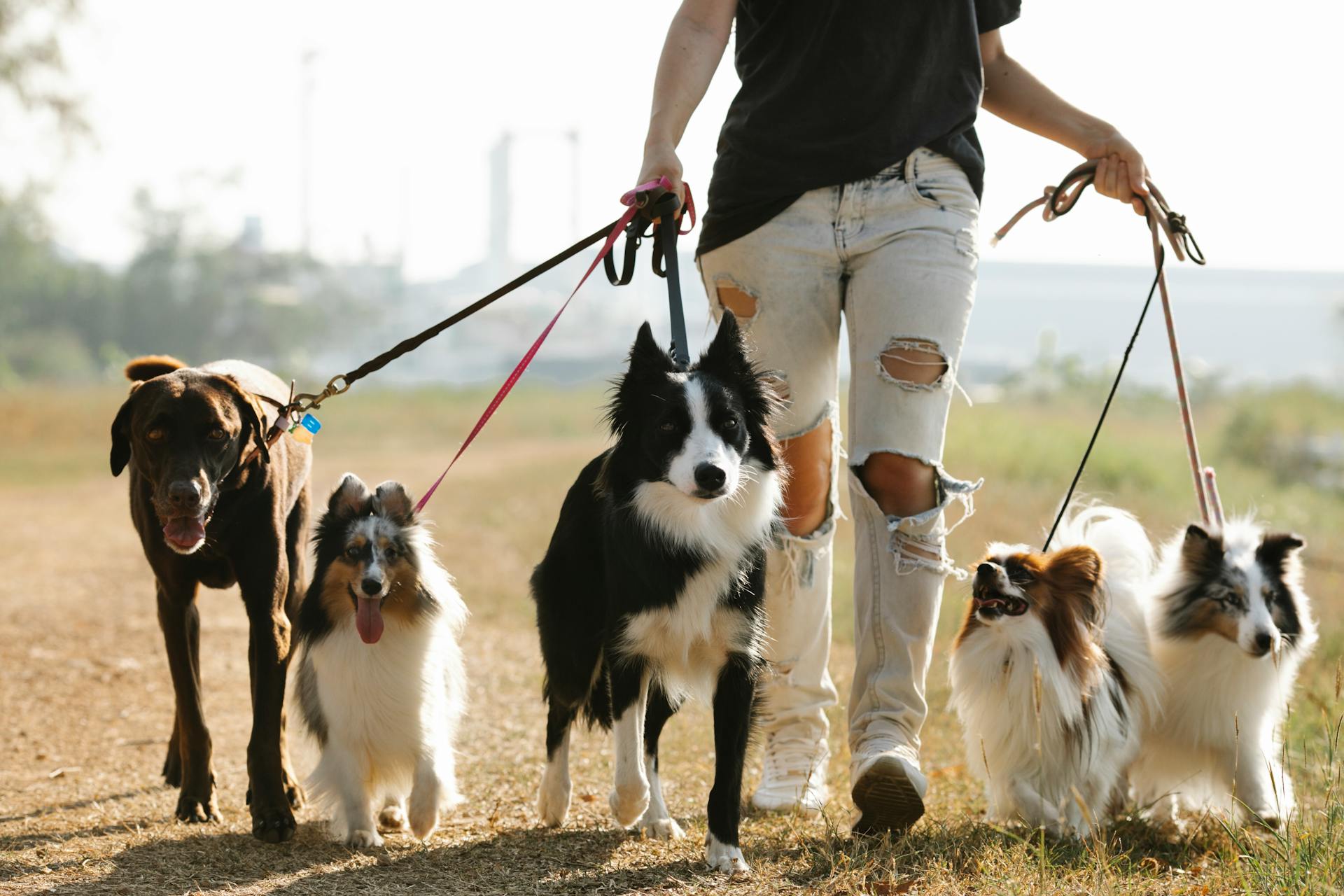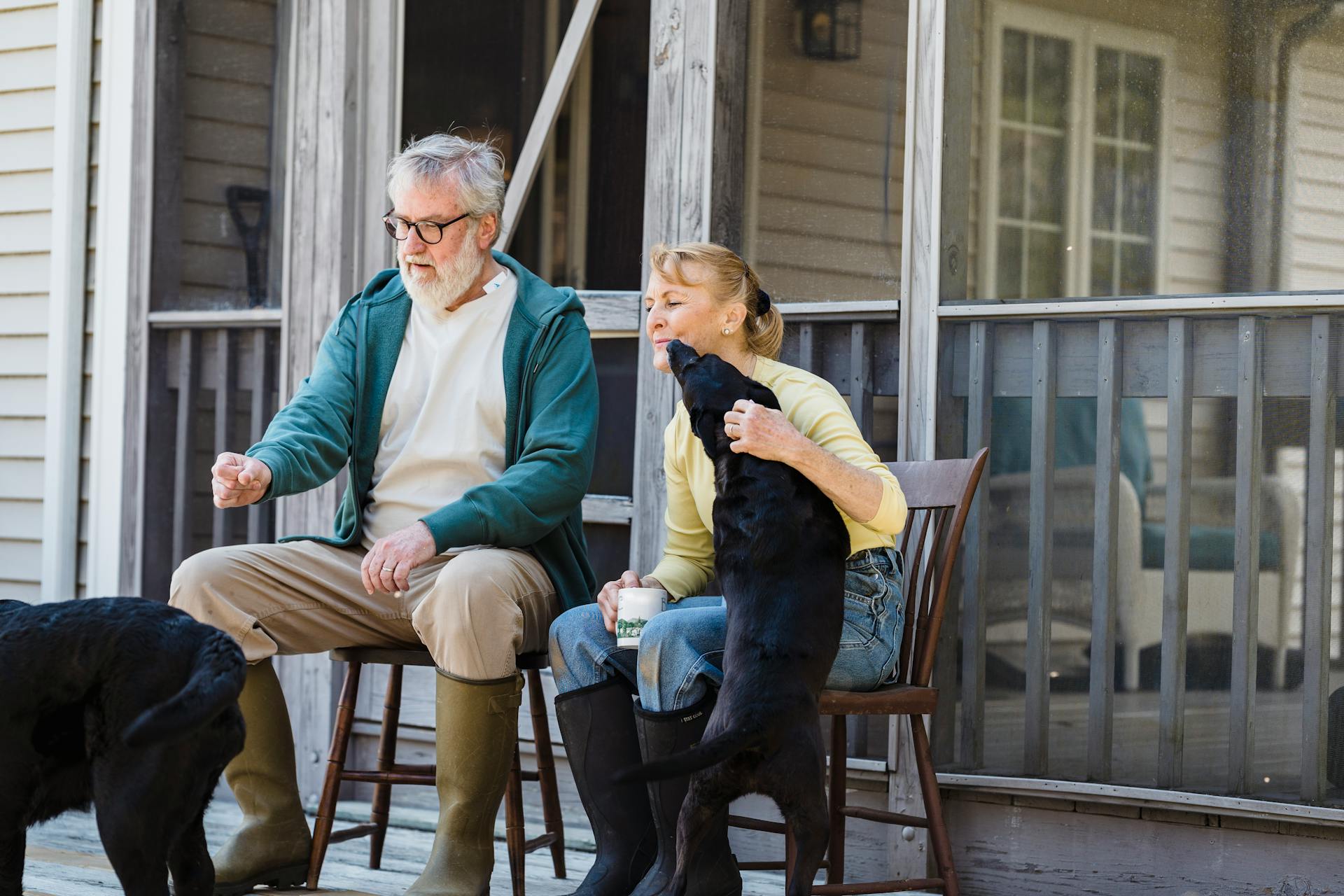
Training a dog to be a lifeguard can be a lifesaving skill. According to the American Kennel Club, lifeguard dogs can be trained to detect drowning people and alert lifeguards.
These dogs can be trained to respond to various commands, such as "find the swimmer" and "alert the lifeguard." They can also be trained to retrieve a flotation device and bring it back to the lifeguard.
A well-trained lifeguard dog can make a huge difference in preventing drowning and saving lives.
You might enjoy: Medical Alert Dog Training
Training and Practice
Frequent practice is key to developing good behavior and work ethic in your Newfoundland.
Consider working with a licensed trainer who specializes in water rescue to help you and your dog make progress.
To start, practice each command and exercise regularly, even if it's just for a few minutes a day.
Longer swims are also essential to prepare your dog for the time it may take to fully administer a rescue.
Frequent Practice
Frequent practice is essential to encourage good behavior and work ethic in your Newfoundland. Consider practicing with a licensed trainer who specializes in water rescue.
To make practice sessions effective, you should continue to practice each and every command and exercise with your dog. This will help build their confidence and strengthen your bond.
Practicing with your dog regularly will help them adjust to the time it takes to fully administer a rescue. Start by swimming out into the water from the shore and coaxing your Newfoundland to follow you.
Begin with short distances and gradually increase the length of your swims. You can lead your dog out to a certain distance or to a boat where you can then encourage them to take a rope or an object to take back to shore.
Reinforce with plenty of praise and treats for progress, even if it needs some work. This will help keep your dog motivated and engaged.
It's also essential to practice towing a boat with your dog. Have them leap from a boat and then offer up a rope for them to tow the boat with. Coax your dog back to the shore with a verbal command and reward when they begin to swim forward.
For more insights, see: Back to Basics Dog Training
Midwest Club Trains Newfoundlands for Rescues
The Midwest Club trains Newfoundlands for rescues. Their goal is to create well-behaved dogs that can thrive in new homes.
These dogs are rescued from shelters and given a second chance at life. They're often in need of socialization and basic obedience training.
The club's training program focuses on positive reinforcement techniques. This approach encourages good behavior without punishing bad behavior.
They also teach the dogs basic obedience commands like "sit", "stay", and "walk on a leash." This helps them become more adoptable and easier to care for.
Newfoundlands are naturally gentle giants, but they still need training to be well-behaved. The club's experienced trainers work with the dogs to help them reach their full potential.
The club's training program is designed to be fun and engaging for both the dogs and the trainers. They use positive reinforcement techniques to encourage good behavior and build strong bonds between the dogs and their trainers.
Recommended read: Positive Reinforcement Dog Training
Meet America’s First and Only Lifeguard Dogs
Beacon and Buoy are America's first and only lifeguard dogs, trained by the American Academy of Canine Water Rescue.
Beacon has been a lifeguard for a year, while 11-month-old Buoy is a more recent hire. They're both Newfoundlands, a breed known for their superior swimming abilities and fluffy coats that keep them warm in cold water.
Beacon's career is already ahead of where Buoy is at the same age, thanks to training with her. This is a testament to the effectiveness of their training program.
Newfoundlands make perfect lifeguard dogs, and they get along great with their human coworkers. In fact, they're so popular that beachgoers are spending more time at the lifeguard stand just to meet them.
Beacon and Buoy are not only adorable, but they're also helping to promote water safety. Beachgoers are asking questions and learning more about safe swimming practices.
Rescue Techniques
Dogs can be trained to locate people in distress in various environments, including water and rubble.
A key part of lifeguard dog training is teaching dogs to respond to commands in high-stress situations.
Dogs can be trained to detect subtle changes in water temperature and chemistry to locate people in distress.
Their keen sense of smell allows them to track scents that may be undetectable to humans.
Lifeguard dogs can be trained to navigate through rubble and debris to locate missing people.
Their agility and strength enable them to move through tight spaces and heavy debris with ease.
Dogs can be trained to respond to a variety of distress signals, including whistles and verbal commands.
Their ability to respond to multiple commands makes them invaluable in search and rescue operations.
Lifeguard dogs can be trained to locate people in a variety of environments, including water, rubble, and dense vegetation.
Their keen sense of smell allows them to track scents that may be hours old.
Dogs can be trained to respond to commands in a variety of weather conditions, including rain and fog.
Their keen sense of hearing allows them to locate sounds that may be muffled or distant.
On a similar theme: How Are Drug Sniffing Dogs Trained
Background and Preparation
To start lifeguard dog training, it's essential to have a solid foundation in basic obedience skills. Your dog should already know how to sit, stay, and come on command.
A lifeguard dog needs to be able to withstand the physical demands of beach work, so they should be in good physical condition and have a strong immune system.
QA
Lifeguard dogs can be trained to respond to various types of emergencies, including water rescues.
Their training involves socialization, obedience, and specific tasks like swimming and diving to retrieve people in distress.
Dogs can be trained to respond to commands like "jump in" and "stay by my side" to ensure their safety and effectiveness.
Their coats may get wet, but lifeguard dogs are naturally buoyant due to their dense fur and body structure.
In the event of a water rescue, a lifeguard dog can weigh down a person in distress, preventing them from floating away.
Their training also includes learning to navigate through rough waters and strong currents.
On a similar theme: Dog Training Water Pistol
Frequently Asked Questions
What is the best dog for a lifeguard?
For lifeguard roles, popular breeds include Newfoundlands, Golden Retrievers, and Labradors, known for their strong swimming abilities and gentle nature. These breeds are often used as rescue dogs due to their exceptional water skills and temperament.
How are water rescue dogs trained?
Water rescue dogs are trained by having them retrieve specific articles dropped in a body of water, such as a life jacket or boat cushion, while being guided by their handler on shore. This exercise simulates real-life water rescue scenarios, teaching the dog to locate and retrieve items in emergency situations.
Sources
- https://www.wpr.org/animals/dog-lifeguards-midwest-club-trains-newfoundlands-water-rescues
- https://www.pedigreedatabase.com/community.read
- https://www.lifenatural.it/en/uncategorized/lifeguard-dog-how-to-become-one/
- https://www.inspiremore.com/meet-americas-first-and-only-lifeguard-dogs-beacon-and-buoy/
- https://wagwalking.com/training/train-a-newfoundland-for-water-rescue
Featured Images: pexels.com


